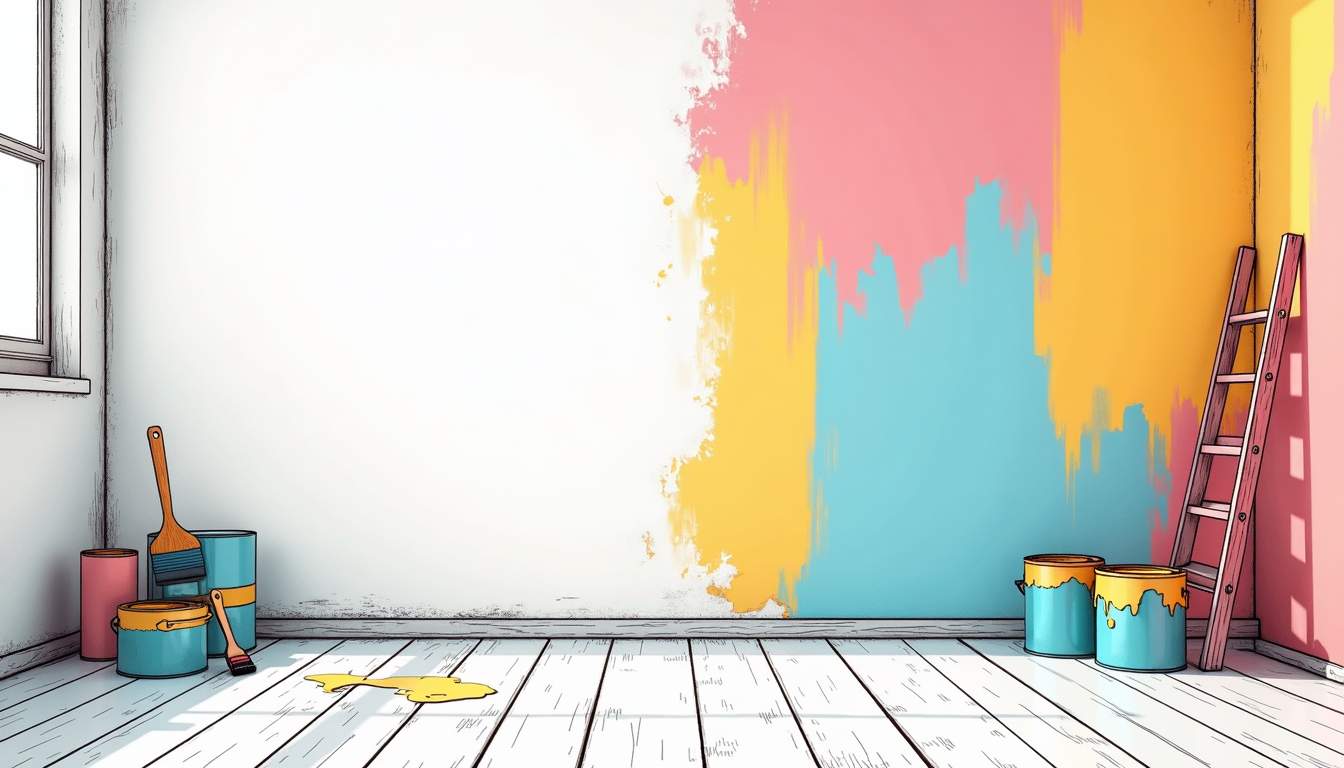
Imagine walking into a room that instantly lifts your spirits. The walls don’t just hold up the ceiling-they tell a story, set a tone, and even influence how you feel. Painting isn’t just about aesthetics; it’s about creating an environment that supports your well-being and reflects your personality. A fresh coat of paint can do more than change colors-it can change your life.
The Psychology Behind Color Choices
Colors have a profound effect on our emotions and behavior. It’s not just superstition or old wives’ tales—scientific studies back this up. For example, blue hues tend to calm the mind and reduce stress, making them ideal for bedrooms or home offices. On the other hand, warm colors like reds and oranges can energize a space, perfect for kitchens or workout rooms. This interplay between color and emotion is deeply rooted in our psychology, influencing not only personal spaces but also commercial environments. Retailers often use color strategically to evoke specific feelings in customers, encouraging them to linger longer or make purchases.

Choosing the right color isn’t about following trends blindly; it’s about understanding how different shades interact with your mood. Soft greens and earthy tones foster relaxation and balance, often used in living rooms or meditation spaces. Meanwhile, yellows can spark creativity and optimism, great for playrooms or craft areas. Additionally, the cultural context of color cannot be overlooked; for instance, while white is often associated with purity in Western cultures, it can symbolize mourning in some Eastern traditions. This duality highlights the importance of personal and cultural significance when selecting colors for your environment.
How Lighting Affects Color Perception
Natural and artificial lighting dramatically influence how paint colors appear. A shade that looks bright and cheerful in daylight might feel dull or harsh under fluorescent bulbs. Before committing, it’s wise to test paint samples on your walls at different times of day. This simple step prevents surprises and ensures the color harmonizes with your room’s lighting. Additionally, the type of finish you choose—whether matte, satin, or glossy—can also affect how colors are perceived, as different finishes reflect light in unique ways, altering the overall ambiance of the space.
Consider the direction your windows face. North-facing rooms often receive cooler, less direct light, which can mute warm colors. South-facing rooms get more sunlight, making colors appear warmer and more vibrant. Adjust your paint choices accordingly to keep the mood consistent throughout the day. Moreover, layering different light sources, such as ambient, task, and accent lighting, can enhance the color experience in a room. By strategically placing lamps and fixtures, you can create a dynamic interplay of light and color that evolves from morning to evening, enriching the atmosphere and enhancing the emotional impact of your space. For expert guidance and reliable services, you can visit PS Home Maintenance.
Practical Benefits of a Fresh Paint Job
Beyond mood enhancement, painting serves practical purposes. It protects walls from wear and tear, covers imperfections, and can even increase your home’s value. A well-maintained paint job signals care and attention, which makes a difference whether you’re living in the space or selling it. Regularly updating your paint not only refreshes the aesthetic but also acts as a protective barrier against environmental factors such as humidity and temperature fluctuations, which can lead to mold and mildew growth over time.

New paint can also improve indoor air quality, especially if you opt for low-VOC or zero-VOC paints. These environmentally friendly options reduce harmful fumes, making your home safer and more comfortable. This is particularly important for households with children, pets, or individuals sensitive to chemicals. Additionally, many modern paints are formulated with antimicrobial properties that can help inhibit the growth of bacteria and fungi on painted surfaces, further contributing to a healthier living environment.
Choosing the Right Paint Finish
Paint finishes aren’t just about shine—they affect durability and maintenance. Matte finishes hide imperfections well and create a soft, sophisticated look, but they can be harder to clean. Satin and eggshell finishes strike a balance, offering some sheen with easier upkeep, suitable for living rooms and bedrooms. These finishes are particularly advantageous in spaces where you want to create a cozy atmosphere while still maintaining a level of practicality. They can also reflect light subtly, enhancing the overall brightness of a room without the glare of higher gloss options.
For high-traffic areas like kitchens, bathrooms, or hallways, semi-gloss or gloss finishes provide better moisture resistance and wipeability. Selecting the right finish ensures your walls look great longer and reduces the need for frequent touch-ups. Moreover, gloss finishes can be particularly striking in accent areas, such as trim or cabinetry, where their reflective quality can add depth and dimension to your design. When considering paint finishes, it’s also wise to think about the lighting in the room; natural and artificial light can dramatically change how a finish appears, so testing samples in different lighting conditions can help you make the best choice for your space.
Smart Preparation: The Key to a Flawless Finish
Painting isn’t just about slapping color on walls. Proper preparation makes all the difference between a professional-looking finish and a rushed job. Start by cleaning the walls thoroughly to remove dust, grease, or stains. This helps the paint adhere better and prevents peeling. Using a mixture of warm water and mild detergent can be particularly effective, especially in kitchens or bathrooms where grime tends to accumulate. After washing, rinse the walls with clean water and let them dry completely to ensure the best adhesion for your new paint.
Next, fill holes, cracks, and dents with spackle or filler. Sand these areas smooth once dry. Skipping this step can result in uneven surfaces that ruin the final appearance. Don’t forget to tape off trim, windows, and outlets to keep lines crisp and clean. Using painter’s tape can be a game changer, as it helps to create sharp lines that elevate the overall look of your project. Additionally, consider applying a primer to areas that have been patched; this will help the paint color appear more uniform and vibrant.
Tools That Make Painting Easier
Investing in quality brushes and rollers pays off. Cheap tools often shed bristles or apply paint unevenly, causing frustration and extra work. A good angled brush helps with corners and edges, while a roller covers large areas quickly and smoothly. When choosing paint, opt for a high-quality brand that offers good coverage and durability. This not only enhances the final look but can also save you time and money in the long run, as you may need fewer coats to achieve the desired color depth.
For ceilings or tall walls, consider an extension pole for your roller. It saves your back and speeds up the process. Drop cloths protect your floors and furniture, making cleanup a breeze. These small details add up to a more enjoyable and efficient painting experience. Additionally, a paint tray with a built-in liner can simplify the process of loading your roller, reducing mess and ensuring even distribution of paint. Don’t forget to keep a small brush handy for touch-ups; this can be invaluable for correcting any minor mistakes or drips that may occur during the painting process.
How a Fresh Coat Can Boost Your Mood and Productivity
Walking into a freshly painted room can feel like hitting a reset button. The change in environment often sparks renewed energy and focus. This is especially true in spaces where you work or relax.
Studies show that certain colors can enhance concentration and creativity. For example, soft blues and greens reduce anxiety and improve focus, making them excellent choices for home offices. Meanwhile, vibrant colors like orange can stimulate enthusiasm and social interaction, ideal for dining rooms or creative studios.
Personalizing Your Space Through Color
Your home should reflect who you are. Painting allows you to express your style and preferences without major renovations. Whether you prefer bold, dramatic hues or subtle, calming shades, color can transform your space into a sanctuary or a source of inspiration.
Don’t be afraid to experiment. Accent walls, color blocking, or even murals add personality and depth. A fresh coat of paint is one of the most cost-effective ways to make a big impact.
Maintaining Your Painted Walls for Long-Lasting Beauty
Once your walls look perfect, keeping them that way is easier than you might think. Regular dusting and gentle cleaning with mild soap and water prevent dirt buildup. Avoid abrasive cleaners that can damage the paint.
Address scuffs or chips promptly. Small touch-ups blend seamlessly when done quickly, preventing larger repairs down the line. Keeping humidity levels in check also helps, as excessive moisture can cause paint to peel or mold to develop.
When to Consider Repainting
Even the best paint jobs don’t last forever. Signs it’s time for a refresh include noticeable fading, peeling, or frequent staining that can’t be cleaned. Typically, interior paint lasts 5 to 10 years depending on the room’s use and paint quality.
Refreshing your walls before they look worn can maintain your home’s appeal and keep your environment feeling vibrant and welcoming.
Final Thoughts
Painting is more than a chore-it’s an opportunity to reinvent your space and uplift your mood. Thoughtful color choices, proper preparation, and quality materials come together to create an environment that supports your lifestyle and well-being.

Whether you’re tackling a single room or your entire home, a fresh coat of paint offers a surprisingly powerful way to make a positive change. It’s an investment in your space and yourself, with benefits that go far beyond the walls.



